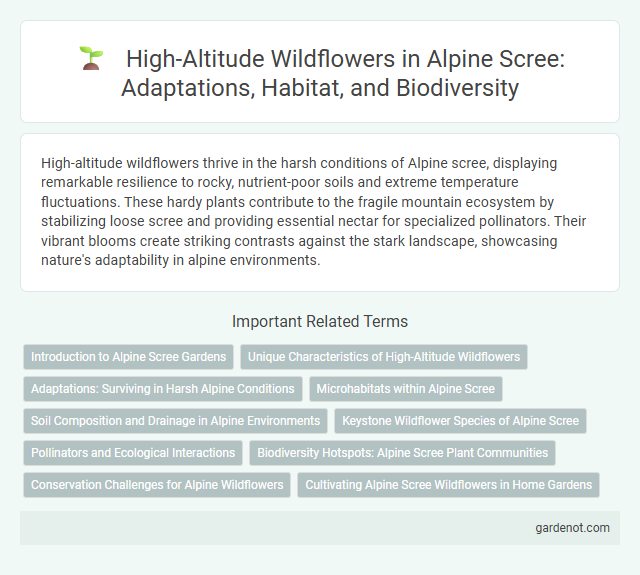High-altitude wildflowers thrive in the harsh conditions of Alpine scree, displaying remarkable resilience to rocky, nutrient-poor soils and extreme temperature fluctuations. These hardy plants contribute to the fragile mountain ecosystem by stabilizing loose scree and providing essential nectar for specialized pollinators. Their vibrant blooms create striking contrasts against the stark landscape, showcasing nature's adaptability in alpine environments.
Introduction to Alpine Scree Gardens
Alpine scree gardens showcase high-altitude wildflowers adapted to harsh, rocky slopes with excellent drainage and minimal soil. These gardens replicate natural scree habitats found above the tree line, where plants like saxifrages, gentians, and saxifrage species thrive in well-drained, nutrient-poor substrates. Cultivating alpine scree environments requires careful selection of drought-resistant, cold-hardy species that flower vibrantly despite extreme temperature fluctuations and high UV exposure.
Unique Characteristics of High-Altitude Wildflowers
High-altitude wildflowers in alpine scree environments exhibit unique adaptations such as deep root systems for stability, frost-resistant tissues, and compact growth forms to minimize exposure to harsh winds. These flowers often possess vibrant pigments that enhance UV protection and attract limited pollinators during short growing seasons. Their ability to survive in nutrient-poor, rocky soils highlights specialized physiological mechanisms for water retention and nutrient uptake.
Adaptations: Surviving in Harsh Alpine Conditions
High-altitude wildflowers in alpine scree exhibit remarkable adaptations to survive extreme conditions such as low temperatures, intense UV radiation, and nutrient-poor soils. These plants often have compact growth forms, hairy leaves that reduce water loss, and deep root systems for stability and moisture absorption. Their ability to photosynthesize efficiently under cold, high-light environments enables sustained growth despite short growing seasons and frequent temperature fluctuations.
Microhabitats within Alpine Scree
High-altitude wildflowers in alpine scree thrive in microhabitats characterized by varying soil composition, moisture retention, and temperature fluctuations, which create niches for specialized plant species like Saxifraga and Eritrichium. These microhabitats often occur in crevices or between loose rocks, providing protection from harsh winds and intense solar radiation, essential for survival in extreme alpine environments. The unique combination of mineral-rich substrates and microclimates supports a diversity of wildflowers adapted to the scree's dynamic and challenging conditions.
Soil Composition and Drainage in Alpine Environments
High-altitude wildflowers in alpine scree thrive in well-drained, rocky soils composed primarily of coarse mineral particles, which facilitate rapid water runoff and prevent root waterlogging. The soil's low organic matter and high mineral content create a nutrient-poor environment, necessitating specialized adaptations in alpine flora to efficiently uptake scarce nutrients. Effective drainage in these steep, rocky slopes reduces microbial activity, influencing soil chemistry and supporting a unique assemblage of drought-tolerant plant species.
Keystone Wildflower Species of Alpine Scree
High-altitude wildflowers such as the Alpine saxifrage (Saxifraga oppositifolia) serve as keystone species in alpine scree ecosystems, providing essential nectar sources and stabilizing fragile rocky substrates. These resilient plants thrive in nutrient-poor, well-drained scree slopes, supporting specialized pollinators and contributing to overall biodiversity. Their presence enhances soil retention and microhabitat formation, critical for sustaining the delicate alpine ecological balance.
Pollinators and Ecological Interactions
High-altitude wildflowers in alpine scree environments play a crucial role in supporting specialized pollinators such as bumblebees and solitary bees, which have evolved to withstand harsh, cold conditions. These plants exhibit mutualistic ecological interactions, providing nectar and pollen that sustain pollinator populations while ensuring cross-pollination for reproductive success. The intricate balance between alpine wildflowers and their pollinators contributes to the biodiversity and resilience of fragile mountain ecosystems.
Biodiversity Hotspots: Alpine Scree Plant Communities
Alpine scree plant communities are vital biodiversity hotspots characterized by specialized high-altitude wildflowers such as Saxifraga, Androsace, and Draba species. These plants exhibit remarkable adaptations to extreme conditions, including high UV radiation, temperature fluctuations, and nutrient-poor soils, ensuring survival and ecological stability. Their presence supports diverse insect populations and contributes to soil stabilization, playing an essential role in alpine ecosystem functionality.
Conservation Challenges for Alpine Wildflowers
High-altitude wildflowers in alpine scree environments face significant conservation challenges due to climate change-induced temperature shifts and habitat fragmentation. These specialized plants rely on the unique microclimate and soil conditions of scree slopes, making them highly sensitive to disturbances from human activity and invasive species. Protecting alpine scree habitats requires targeted efforts to monitor population dynamics, regulate tourism, and implement strategies that maintain ecological integrity under changing environmental conditions.
Cultivating Alpine Scree Wildflowers in Home Gardens
Cultivating alpine scree wildflowers in home gardens requires replicating their native environment of well-drained, rocky soil and high-altitude conditions. Species such as edelweiss, alpine pasque flower, and globe flower thrive when provided with full sun exposure and minimal water, mimicking the harsh alpine scree habitat. Incorporating crushed granite or coarse sand enhances drainage, supporting healthy root development and vibrant blooms.
High-altitude wildflower Infographic

 gardenot.com
gardenot.com